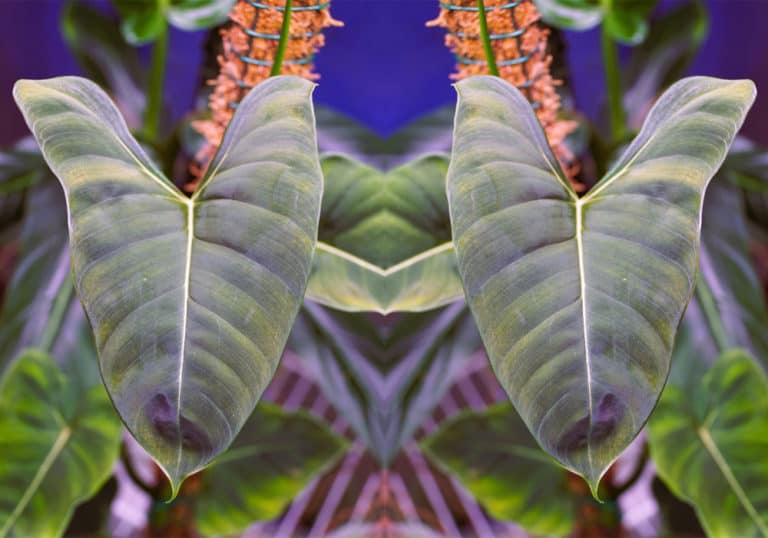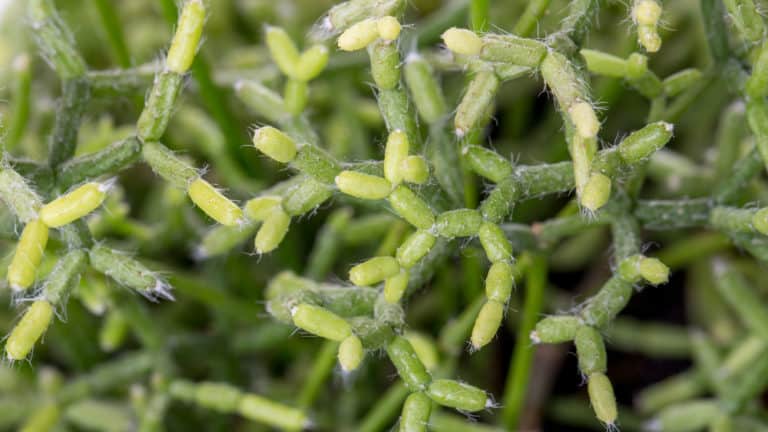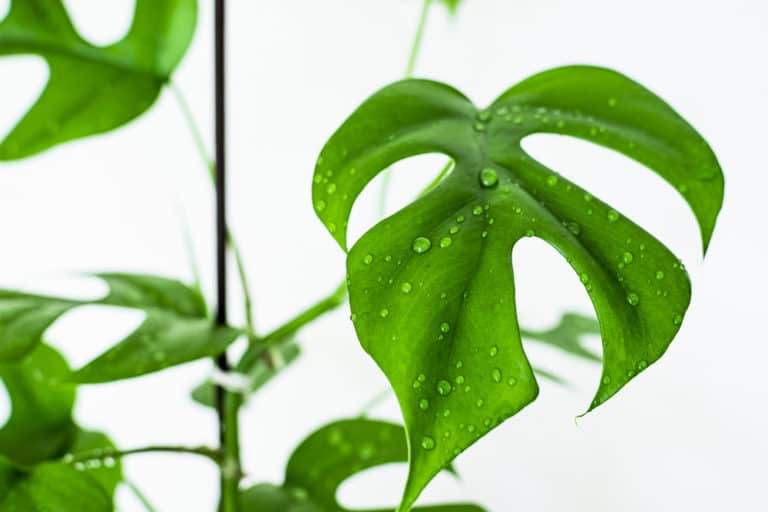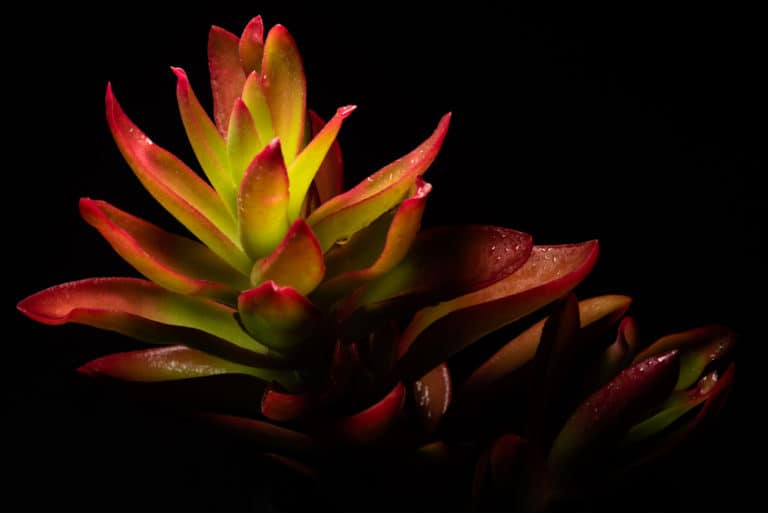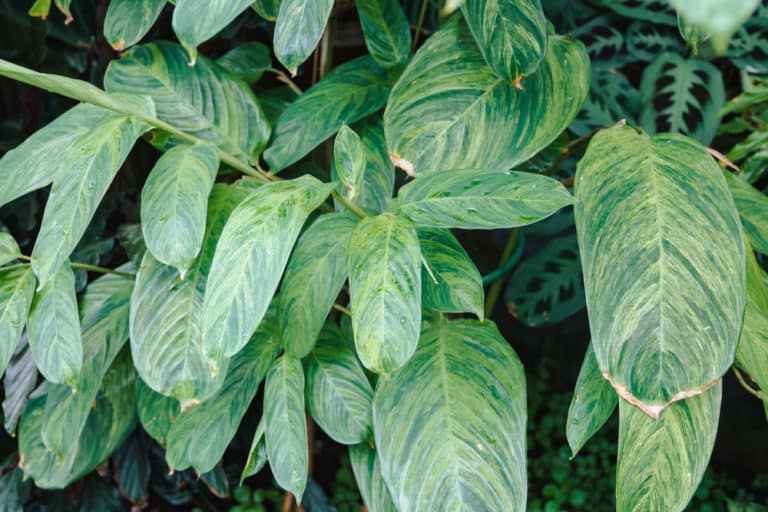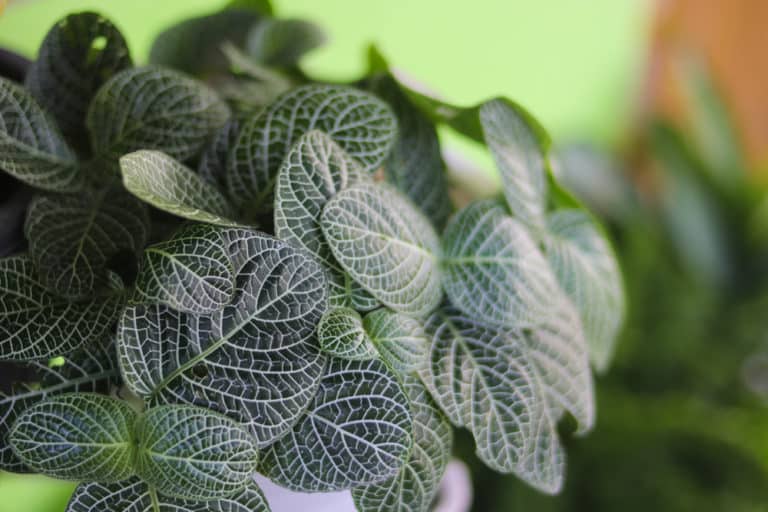Anthurium Clarinervium ‘Velvet Cardboard’ Care Guide (2024)
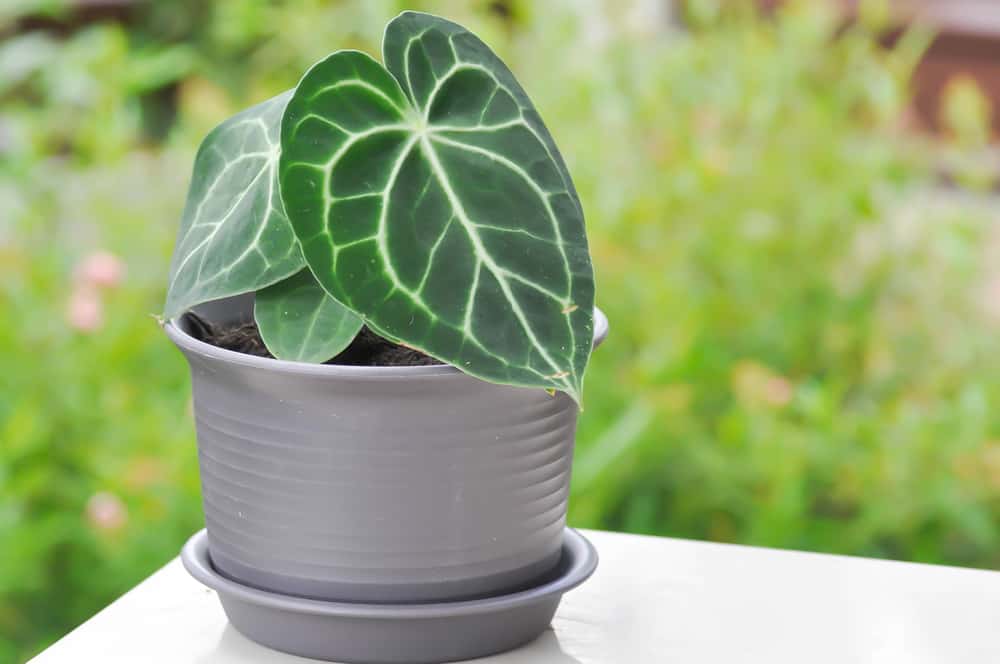
Anthurium clarinervium is one of the Instagram must-have houseplants right now, so count yourself lucky if you are able to find one available to buy at a reasonable price.
Also known as velvet cardboard anthurium or white-veined anthurium, its brilliantly patterned lush leaves will enhance the contemporary or traditional decor.
| Scientific Name | Anthurium clarinervium |
| Common Name | Velvet Cardboard Anthurium, White-Veined Anthurium |
| Light | Medium to bright indirect sunlight |
| Watering | Water if the top 1 to 2 inches of soil are dry |
| Temperature | 68 to 80ºF (20 to 27ºC) |
| Hardiness Zone | 9 to 12 |
| Humidity | 65 to 80% |
| Soil Type | Rich, quick-draining, loamy |
| Soil pH | 5.5 to 6.5 (acidic to mildly acidic) |
| Fertilizing | A balanced feed once a month in spring and summer |
| Repotting | Every 2 years |
| Pruning | Only to remove dead leaves |
| Propagation | Division or seeds |
| Toxicity | Toxic to humans and pets |
| Mature Size | 24 to 30 inches as a houseplant |
| Bloom Time | Spring and summer |
What’s Unique About Anthurium Clarinervium?
The Anthurium clarinervium plant is a lithophyte or epipetric plant native to Chiapas in Mexico, where it grows on limestone outcroppings. It was first described by Eizi Matuda in 1952.
Although many people incorrectly call it an epiphyte, it does not grow on trees.
Anthurium clarinervium plants are currently in demand because of their large, thick, velvety leaves with contrasting white veins.
Growing Anthurium clarinervium is a little more challenging, but an indoor gardener with some experience should have no trouble keeping this tropical beauty happy.
You will also make your home a healthier place, as anthurium plants are excellent at filtering formaldehyde, ammonia, toluene and xylene from the indoors air.
Anthurium Clarinervium Care
In the rocky landscape where the velvet cardboard anthurium originates, this plant is used to hot temperatures and high humidity.
To provide the best Anthurium clarinervium plant care, you should strive to give it similar conditions in your home.
Good clarinervium care involves keeping it in indirect light in a warm and humid location, with regular watering.
Light
While velvet cardboard anthurium grows under the tree canopy of the tropical rainforest, it still gets 5 to 8 hours of filtered sunlight every day.
In your home, Anthurium clarinervium light requirements are for medium to bright indirect light, or between 5,000 to 20,000 lux.
Your clarinervium light needs can be met perfectly in an east or north-facing window, where it will get lots of light without being exposed to the full sun.
If all you have is a south or west exposure, set your velvet cardboard anthurium several feet away from the window, or hang a sheer curtain to filter the light.
Watering
In its native habitat in Chiapas, velvet cardboard anthurium’s watering needs vary with the season.
While it rains frequently from May to October, it rains only once or twice a month from December to March.
Your Anthurium clarinervium watering should reflect that seasonal cycle.
In spring and summer, water clarinervium whenever the top inch or so of the soil has dried out.
However, in winter you can let the soil almost completely dry out before giving it a thorough soaking.
Try to use rainwater or distilled water, but if you must use tap water, let it sit for 24 hours to gas off the fluoride and chlorine.
Temperature
It is hot in southern Mexico. In Chiapas, the average high never drops below 88ºF (31ºC), and nighttime lows stay above 68ºF (20ºC).
Based on that, the recommended Anthurium clarinervium temperature range is from 68 to 80ºF (20 to 27ºC).
You can drop the temperature for clarinervium down to about 60ºF (15ºC) at night, but it has diminished temperature tolerance below 55ºF (13ºC).
Like so many tropical natives, velvet cardboard anthurium will appreciate a summer stint in a shady spot outdoors when it’s hot and steamy.
However, it has no frost hardiness at all, so bring it in as soon as temperatures start to drop.
Humidity
Even in the dry winter season, the humidity level in Chiapas barely falls below 70%, so velvet cardboard anthurium is used to a moist environment.
Anthurium clarinervium humidity requirements are one of the most demanding parts of caring for this rainforest native. The ideal humidity for clarinervium is between 65 to 80%.
You will not be able to keep your whole home at that level, so you will need to find ways to create a bubble of humidity around your velvet cardboard anthurium.
Misting the foliage is a bad idea, as the leaves can develop fungal diseases easily.
Instead, group all your houseplants together, which can naturally increase the humidity level.
However, you will probably find that you will need a small humidifier to really do the job right.
Soil
In its native rainforests, velvet cardboard anthurium grows in crevices in limestone outcrops, so it’s used to very loose, well-draining soil.
Your velvet cardboard anthurium soil also has to retain a moderate amount of moisture at the same time that it lets the roots breathe.
The recommended pH level for clarinervium is 5.5 to 6.5, or acidic to mildly acidic.
It’s best to make a custom soil mix for your Anthurium clarinervium soil; an ideal combination would be equal parts sphagnum peat moss, orchid bark, and perlite.
You can also substitute a regular potting mix for the peat moss if you prefer.
However, you can also use a commercial orchid or aroid soil for clarinervium.
Fertilizer
While velvet cardboard anthurium isn’t a heavy feeder, using fertilizer for clarinervium every month during the growing season will help it grow the biggest and best foliage.
The best Anthurium clarinervium fertilizer is a standard liquid houseplant formula with a fertilizer ratio of 20-20-20. Look for one without urea.
Dilute the solution to half the recommended strength and pour it evenly over the soil surface right after you’ve watered.
Only water in spring and summer, as the velvet cardboard anthurium stops active growth in fall and winter.
If you see salts crusting on the soil surface, it’s time to flush the soil. Run a gentle stream of water through it for a few minutes to get rid of excess fertilizer.
Potting & Repotting
Anthurium clarinervium repotting is usually necessary every 2 years, but instead of sticking to a strict schedule, watch for signs of it becoming rootbound.
If you can see roots coming out of the bottom of the pot, or pushing up to the soil surface, it’s time for repotting clarinervium.
One quirk of velvet cardboard anthurium is that the roots often attach themselves to the inside of the pot, so you may have to cut off a plastic pot or break apart a clay one.
Only increase the pot size by a couple of inches, so as not to overwhelm the roots with too much soil. A plastic one with good drainage is ideal.
Always use fresh potting soil after cleaning off as much of the old stuff as possible.
Pruning
Velvet cardboard anthurium leaves are so big and gorgeous that you will not want to sacrifice a single one to unnecessary pruning.
As well, cutting off leaves will slow down its growth, as it needs them for photosynthesis.
The only Anthurium clarinervium pruning that is absolutely necessary is cutting clarinervium leaves that are dead or damaged severely. Cut or snap the petioles off where they meet the main stem.
For other minor blemishes such as browned tips or margins, you don’t have to cut off the whole leaf; simply trim away the discolored bits with very sharp, sterilized small scissors.
Propagation
There is one really foolproof way to propagate clarinervium.
If you’re already repotting your plant, Anthurium clarinervium propagation can easily be done by division, as it naturally develops offsets or pups as it grows.
Once you’ve cleaned off the root ball, you should be able to see small new plants with their own roots and leaves. Gently untangle these pups from the mother plant and pot each one up separately.
The other method for propagating Anthurium clarinervium is by using seeds. If your own plant has flowered and set fruit, you may have to wait for a year for them to ripen sufficiently to be able to plant the seeds.
Also, make sure to check out our in-depth Anthurium veitchii plant care guide.
Common Problems of Anthurium Clarinervium
There are some potential Anthurium clarinervium problems, but you should be able to avoid most of them.
The majority of the problems with clarinervium are caused by poor growing conditions, so if you are careful from the beginning, you should be fine.
However, be vigilant and keep an eye on the leaves, as they will be the first to show that there’s something wrong.
Pests
You can use a neem oil or insecticidal soap spray periodically to deter Anthurium clarinervium pests, but because clarinervium leaves should never be left wet, gently blot them dry after half an hour.
You may see the webs and the yellow bumps spider mites leave behind. It’s best to rinse them off in the shower or sink, but carefully dry the leaves afterwards.
If you see small black flies, that’s probably fungus gnats. Use yellow sticky traps for the adults, and drench the soil with hydrogen peroxide in water to kill the larvae.
Mealy bugs will form fluffy white clumps on the underside of the leaves. Wipe them off with a cotton ball soaked in rubbing alcohol.
Diseases
The best way to avoid Anthurium clarinervium diseases is by maintaining good watering practices. Never leave the soil sopping wet, and keep your Clarinervium leaves dry.
However, if diseases do develop, you should be able to cure your plant.
Leaf spot is a catchall term for several different fungal or bacterial diseases. In all of them, you will see spots of various colors develop on the leaves, sometimes spreading and killing the whole leaf.
Root rot is a fungal disease that starts when the soil is wet and the roots are cut off from air. The leaves turn yellow and droop, the stems get mushy, and the roots turn black and smelly.
For all of these afflictions, cut off all the infected parts and replant it in fresh soil in a disinfected pot.
Growing Problems
You may encounter other growing problems caused by poor growing conditions. If you can correct that, you should be able to save your sick plant.
Yellow leaves could be caused by several different factors. You may not be giving your velvet cardboard anthurium enough light, or perhaps you are using tap water with fluoride and chlorine.
Another common cause of yellowing leaves is overwatering.
Finally, your velvet cardboard anthurium may need more fertilizer, but only go to that as a last resort, as too much will damage the plant as well.
Brown tips have one main cause, and that is low humidity.
Toxicity of Anthurium Clarinervium
Clarinervium is toxic to humans and pets because of the calcium oxalate crystals found in all parts of the plant.
While its toxicity level is fairly low, exposure to the raphides in the foliage and sap can still cause considerable physical distress, and occasionally can be fatal if not treated.
For Humans
Velvet cardboard anthurium is toxic to humans, but is usually more of an irritant than a serious toxin.
You should wear gloves when handling the plant, and avoid getting the sap on your skin or in your eyes.
Children are more at risk than adults, because they are more likely to try eating the foliage, and their smaller body mass makes a lower dose more potent.
If your child only takes a nibble of a leaf, they will almost immediately experience sharp pain in and around their mouth.
Rinse their mouth out and wipe away any plant material you see. Give them something soothing and cold for the pain.
However, a swollen tongue or obstructed airway is a sign of a more serious reaction. Take them to the emergency room immediately.
For Pets
Pets are at an elevated risk if they ingest some velvet cardboard anthurium foliage. If you want to grow it in a household with them, be prepared to take some precautions.
If your cat, dog, or rabbit eats a leaf, and develops symptoms such as drooling, vomiting, wheezing, or diarrhea, take it to the veterinarian for immediate care. They could suffer long-term internal damage if not treated.
It’s best to position your velvet cardboard anthurium somewhere out of reach of all of the small members of your household.
Since it remains a relatively small size, placing it on a mantlepiece or pedestal can keep your creatures safe.
Anthurium Clarinervium Appearance
The exotic, luxurious Anthurium clarinervium appearance has made it an Instagram star in the last few years, and with good reason.
The bright white veins against their velvety green background make it pop. It’s going to look as good in a fresh, contemporary white loft as in a vintage-inspired cottage.
Foliage
The foliage of Anthurium clarinervium is dramatic and opulent, and will put on an impressive show within a couple of years.
Each leaf is a light yellow-brown when it first emerges, but they change to olive green and then mature to a deep, rich green. The veins provide a striking contrast, as they are bright white. The underside is a much lighter shade of green.
The upper surface has a rich, velvety surface, and the leaves are thick and stiff, leading to the common name velvet cardboard anthurium.
Leaves can be 4 to 10 inches long and 3 to 7 inches wide, in an almost perfect heart shape with an elongated tip.
Flowering
While it is not unusual to see a clarinervium flower when your plant is a few years old, they are not anywhere near as desirable as the foliage.
Some anthurium varieties are prized for their flowers, but Anthurium clarinervium flowering is not much to look forward to.
Blooming usually occurs in late spring and early summer, consisting of a pale green and purple spadix wrapped in a similarly colored spathe. They last about 5 days.
If they are pollinated, the flowers are followed by long-lasting clusters of orange berries.
However, many growers simply choose to cut out the flower stalks as they emerge, preferring that their velvet cardboard anthurium concentrate its energies on growing more big, beautiful leaves.
Size and Growth
The mature size of Anthurium clarinervium grown indoors is usually 24 to 30 inches tall with a similar spread.
It has a slow growth rate, and can be expected to take 5 to 8 years to reach its full size. It may only produce 1 or 2 new leaves in each growing season.
Leaves are attached to the main stem by long, thin, round petioles which stand stiffly upright, with the leaves hanging down almost perfectly horizontally.
Velvet cardboard anthurium grows into a wide, bushy plant, fully erect and with no vines or trailing stems. It does not need to be staked.
Anthurium Clarinervium Fragrance
There is no Anthurium clarinervium fragrance. Neither the flowers have nor the evergreen foliage have a scent.
However, velvet cardboard anthurium is an excellent air purifier, as all anthuriums are known to filter formaldehyde, ammonia, toluene and xylene. That’s even more beneficial than a pleasant scent.
As well, scentless indoor plants are often preferred to ones with a heavy fragrance, especially in enclosed spaces like a small office or city studio apartment.
Since some people have allergies to strong scents, many public places such as medical offices and shopping malls prefer to use ones without a fragrance. Velvet cardboard anthurium is perfect in those settings.
Suggested Uses for Anthurium Clarinervium
Anthurium clarinervium is such a gorgeous foliage plant that it’s perfect for using in a variety of locations indoors.
As long as you can provide it with the high humidity that it craves, and you can keep it out of the full sun, you should be able to set this compact plant almost anywhere.
Try putting it in your bathroom, where the high humidity levels will keep it very happy.
Because of its dramatic dark leaves with their brilliant veins, it’s an ideal plant for placing on its own on a mantlepiece or pedestal like a living piece of art.
FAQ
What is Anthurium clarinervium?
Anthurium clarinervium is a small evergreen perennial plant native to the tropical rainforests of Chiapas, Mexico, where it grows on the limestone karst. It is grown for its striking foliage.
How to identify Anthurium clarinervium?
Anthurium clarinervium has large velvety leaves that mature to a dark green, with bright white contrasting veins. The leaves have a broad heart shape and a stiff texture.
How to care for Anthurium clarinervium?
Anthurium clarinervium plants should be grown in medium to bright indirect light and watered regularly in soil that drains quickly, in a warm and humid location.
How to grow Anthurium clarinervium indoors?
Anthurium clarinervium can be grown indoors at normal room temperatures with high humidity, in a spot out of the full sun and protected from drafts.
How to grow Anthurium clarinervium outdoors?
Anthurium clarinervium can be grown outdoors all year in growing zones 9 to 12, either in a container or as a landscape plant, where it may reach 6 feet in height.
How fast does Anthurium clarinervium grow?
Anthurium clarinervium has a slow growth rate, taking up to 8 years to reach full size, with only 1 or 2 new leaves every year.
How tall does Anthurium clarinervium grow?
Anthurium clarinervium usually tops out at 2 feet or so indoors as a potted plant, but in a tropical climate outdoors may reach 6 feet.
How to make Anthurium clarinervium grow faster?
Anthurium clarinervium will grow the fastest when kept in its ideal indirect but bright light, consistently moist soil and warm temperatures with very high humidity.
How to stake Anthurium clarinervium?
Anthurium clarinervium is not a climbing plant, so it does not need to be staked, as the stems stay stiff and erect without any support.
How to pot Anthurium clarinervium?
Anthurium clarinervium should be potted in a plastic or glazed container with good drainage holes, in a very loose and porous soil with a fair amount of organic matter.
How to revive Anthurium clarinervium?
If your Anthurium clarinervium has soil that has dried out, set the pot in a pail or sink filled with tepid water, and let it become saturated before draining all the excess.
Why is my Anthurium clarinervium dying?
Your Anthurium clarinervium may be dying because it has developed a fungal or bacterial disease from poor watering practices. Cut back to healthy tissues and replant it in fresh soil.
Why is my Anthurium clarinervium drooping?
Your Anthurium clarinervium may be drooping because it is underwatered or over watered. Check the soil moisture levels and either give it a good soaking or repot it in porous soil.
How cold can Anthurium clarinervium tolerate?
Anthurium clarinervium can handle temperatures as low as 60ºF (15ºC) at night, but anything below 55ºF (13ºC) will stop growth and damage the foliage. Frost will kill it.
How to get rid of pests on Anthurium clarinervium?
Anthurium clarinervium pests can be controlled with sprays of insecticidal soap or neem oil used on a regular basis. Just be sure to dry the leaves afterwards.
Is Anthurium clarinervium toxic to cats?
Yes, Anthurium clarinervium is toxic to cats. If your cat ingests some foliage and starts vomiting, drooling, or wheezing, you should take it to the veterinarian immediately.
Is Anthurium clarinervium toxic to dogs?
Yes, Anthurium clarinervium is toxic to dogs. If your dog starts drooling excessively, drooling, wheezing, or has vomiting or diarrhea, it needs medical attention at once.
Is Anthurium clarinervium toxic to children?
Yes, Anthurium clarinervium is toxic to children. If your child has eaten some of it and has a swollen tongue or throat, you should take them to the emergency room.
Is Anthurium clarinervium toxic to humans?
Yes, Anthurium clarinervium is toxic to humans and can cause a rash. If you get some of the sap on your skin, rinse it off.
Does Anthurium clarinervium have a scent?
Anthurium clarinervium foliage and flowers do not have a fragrance, so it is suitable for use where people with a fragrance allergy may be exposed to it.

